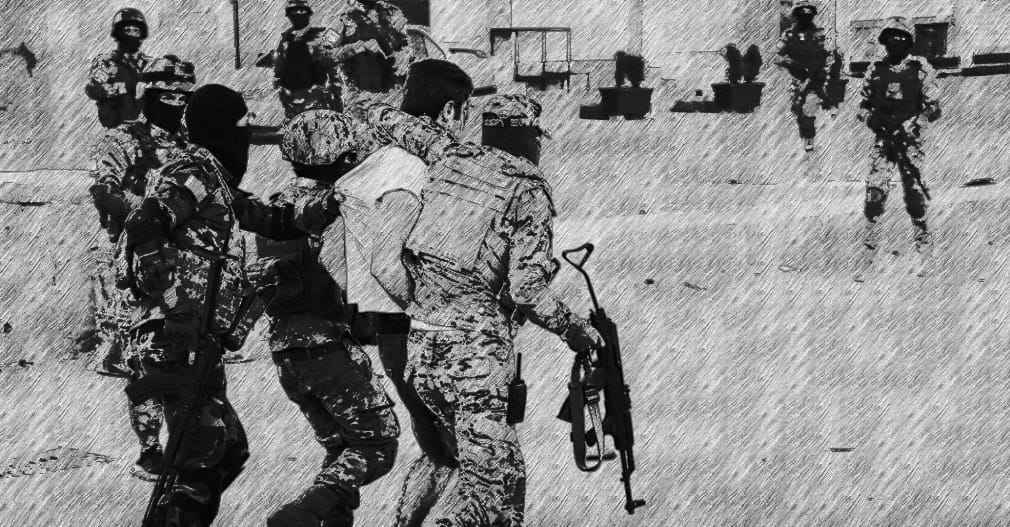Introduction:
In February 2024, years after displacement, Hanan Hussein returned to his village in Afrin countryside in order to take care of his elderly mother following his father’s death. He was surprisingly arrested by forces of the opposition Syrian National Army (SNA) and was released only after paying 7,000 USD as a ransom.[1]
However, the situation didn’t stop there. Hussein was arrested again, by the Military Police this time, during a visit he conducted to the Local Council in Afrin. He was accused of the common charge against Kurdish residents of Afrin, which is having ties with the Autonomous Administration/the Syrian Democratic Forces (SDF). Hussein remained detained for about a month before being released after paying 2,000 USD as a ransom. Forced to succumb to extortion to care for his elderly mother, he remains deeply concerned and fears the continuation of such violations against him, especially due to the absence of effective mechanisms for victims’[2] redress.
Hussein’s story as well as other incidents documented by Synergy since early 2024, illustrate the extent of tightening imposed on Afrin’s native people who seek to return to their homes to manage their properties or take care of their relatives. This explains why thousands of enforced migrants of Kurdish families refrain from returning, fearing arbitrary arrest, enforced disappearance, torture, extortion, and other documented violations by factions the SNA factions, which Turkey has entrusted with managing the region since its occupation in 2018.
Dozens of victims, whose Synergy documented their arrest cases, remain forcibly disappeared in SNA-run prisons in Afrin, Ras al-Ayn/Serê Kaniyê and Tall Abyad/Girê Spî. Three of the victims are persons of special needs, two of whom are women. Meanwhile, others have been released in exchange for financial ransom.
Arresting, continuously and repeatedly, the returnees to Turkish-occupied regions, like Afrin and Ras al-Ayn/Serê Kaniyê, indicates that there is a systematic target of the Kurds. The returnees are frequently accused of dealing with the Autonomous Administration or the SDF. Such pattern of violations reflects some systematic oppressive policies that aim to intimidate the Kurds and alienate them from their homelands.
These violations also reflect the ongoing state of insecurity and instability in the Turkish-occupied areas in northern Syria and the absence of justice and accountability. The lack of effective remedy mechanisms for the victims means that the perpetrators and violators remain beyond accountability, thus encouraging the commission of these violations, in light of the judicial system’s inability or unwillingness in those areas to address these transgressions fairly and effectively.
The Escalation of Arrests in Turkish-Occupied Regions:
During the first five months of 2024, Synergy documented the arrest of at least 308, including 13 women and five children, at the hands of Turkish forces and the Turkish-backed SNA in Afrin, Ras al-Ayn/Serê Kaniyê and Tall Abyad/Girê Spî. 103 out of the total toll of detainees were released while the fate of 205 persons remains unknown.
By comparing the first five months of 2023 to those of 2024, it can be noted that cases of arbitrary arrests in Afrin, Ras al-Ayn/Serê Kaniyê and Tall Abyad/Girê Spî have doubled, rising from 155 cases in 2023 to 308 in 2024. The perpetuation and escalation of arbitrary arrests in the SNA-held areas, with the support of Turkish forces, further complicates the security situation and deepens suffering of the local people, specifically the returnees.
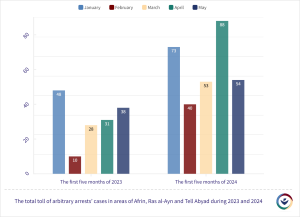
The monitored and documented arrest cases in Ras al-Ayn/Serê Kaniyê and Tall Abyad/Girê Spî were 129, while in Afrin they were 179. Forces of the Military Police was the party responsible for the majority cases of arrests, followed by forces of the Civil Police, then Sultan Murad Brigade, the security forces, and the Turkish intelligence. Other separate arrests were carried out by other SNA’s factions like al-Hamza (al-Hamzat) Division, Sultan Suleiman Shah (al-Amshat), and Tajammu Ahrar al-Sharqiya/Gathering of Free Men of the East, and others.
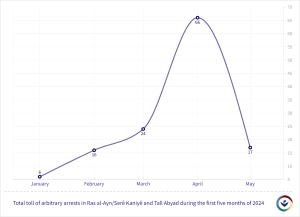
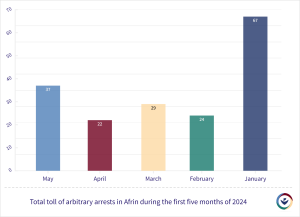
The SNA conducted no investigations in its forces’ practices, which continue to arrest civilians ensuing them forcibly disappeared persons and violating their rights, nor did the Turkish government that has effective command and control on these forces to change their arbitrary conduct. On the contrary, it appears, in some cases, that the Turkish government was involved as a partner in committing such violations.
Therefore, the Turkish military commanders are held criminally responsible for violations committed by the SNA forces in instances where the Turkish leaders knew or should have known about such crimes or failed to take all necessary and reasonable measures to prevent their commission.[3]
As an occupying power, the Turkish authorities must ensure that their own officials and those under their command in the SNA do not arbitrarily detain or mistreat anyone. The Turkish authorities are also obliged to investigate alleged violations and ensure that those responsible are appropriately punished.
Overall, the reiteration of these incidents refelcts the existence of a suppressive environment that does not encourage a voluntary and safe return of the displaced persons or enforced migrants to their Turkish-occupied homelands, resulting in constant displacement and social instability in the region.
Arrests as a Repeated Pattern and Widespread Systematic Practice:
Motives behind the majority of detention and deprivation of liberty operations in areas of Afrin, Ras al-Ayn/Serê Kaniyê and Tall Abyad/Girê Spî were to extort the victims and their families to get financial ransoms or for intimidation purposes to push them to leave the area. Some civilians, including three with special needs and two women, were arrested by Sultan Suleiman Shah (al-Amshat) because they demanded to restore their seized properties. The victims are still in custody.
Moreover, Synergy documented cases of arresting some asylum seekers, who were subjected to torture and cruel treatment by the Turkish Border Guards (Gendarmerie) before handing them over to forces of the Military Police in the SNA. The fate of 36 detainees, out of the 114 documented arrestees in this report, is still unaccounted for.
In four cases, families of the detainees were forced each to pay 2,900 USD for their release, whereas in other three cases, the families were asked to pay 25,000 USD as a ransom. Due to their inability to pay, the three victims remain detained and forcibly disappeared.
A witness, who hailed form the west countryside of Ras al-Ayn/Serê Kaniyê, told Synergy that he had witnessed a joint patrol of the Sultan Murad Brigade and forces of the Military Police arresting two of his neighbors, who were brothers, while they were working in planting crops and porterage to secure their livelihoods. The two were assaulted, severely beaten, blindfolded, and handcuffed on full view of their neighbors and were accused of dealing with the Autonomous Administration/the SDF. This incident illustrates the arbitrariness of the arrests, as the witness mentioned that the reason for the arrest was the brothers’ objection to the patrol members searching and raiding several homes in the village without valid justification.[4]
The analysis of information documented by Synergy about the arbitrary arrests in Afrin, Ras al-Ayn/Serê Kaniyê and Tall Abyad/Girê Spî, showed the involvement of the opposition SNA’s factions in arrest cases as follows: forces of the Military Police implemented 141 arrests, the Sultan Murad Brigade 58 arrests, forces of the Civil Police 54 arrests, while other factions carried out other arrest cases. Furthermore, the Gendarmerie and the Turkish intelligence carried out 38 arrest cases. At least, six detained was confirmed to be transferred to the Turkish land.
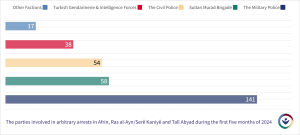
Within the context of these arrests, it is important to note that the Turkish intelligence oversees, or at least has extensive knowledge of the process of arrest and enforced disappearance, as well as the types of torture accompanying them. “Ongoing abuses including torture and enforced disappearances of those who live under Turkish authority in northern Syria will continue unless Turkey itself takes responsibility and acts to stop them,” said Adam Coogle, deputy Middle East director at Human Rights Watch (HRW). HRW’s report, “Everything is by the Power of the Weapon” confirms that “the Turkish Army and the Turkish intelligence agencies are involved in implementing and supervising the violations.”
According to an intelligence briefing published in December 2022, by New Lines Institute: “the Turkish military and intelligence officers heading these centers [Afrin and Ras al-Ayn/Serê Kaniyê] coordinate the distribution of ongoing military responsibilities, make all decisions, and inform the Syrian commanders [SNA commanders], who then carry out the orders.” Since early 2024, Synergy has documented no less than 22 arrests carried out by Turkish intelligence forces.
The continuing, recurrence, and escalation of arbitrary arrests in these territories affirms that these practices are not isolated or random incidents, rather, they are part of a widespread systematic pattern. These ongoing violations clearly refers to a suppressive systematic policy, aiming to intimidate the locals, particularly the Kurds, and forcing them to leave their original places of residence, or reluctantly accepting financial extortion in exchange for their freedom. This systematic pattern of arrests and extortion reflects a high level of organization and coordination among Turkish forces and subordinating factions in these regions, further complicating the security situation and deepening the suffering of the local population.
Inhuman Detention Conditions:
A military source within the SNA told Synergy that he witnessed the arrest of a group of around 50 people at the hands of Sultan Murad Brigade, while they were about to enter Ras al-Ayn/Serê Kaniyê to cross into the Turkish land. 44 persons from the group were released after they altogether paid 13,200 USD to the Brigade, while the other six remained in custody, accused of dealing with the Autonomous Administration/the SDF. According to the witness, interrogation with the detainees was accompanied by various forms of physical torture, including beating, kicking, punching, and beating with cables, in addition to psychological harm, such as verbal abuse and humiliation.
Apparently, dealing with the Autonomous Administration/the SDF remains the most common accusation pointed against the detainees in the Turkish-occupied territories. The witness confirmed that two, out of the six detainees, are from the Arabic component from Syria and that they did not hail from the SDF-held areas. He added that the six were attempting, along with the others, to cross to Turkey illegally and then to travel to Europe.
A report, published by Synergy Association in February 2024, regarding arbitrary arrest and its impacts on the victims and their families, detailed multiple torture methods used by the Turkish-funded and supported SNA’s factions, in Afrin, Ras al-Ayn/Serê Kaniyê and Tall Abyad/Girê Spî strips. The report was based on information analysis of 34 testimonies collected from survivors, in addition to six other testimonies documented by Synergy in March and April 2024. The cross-checked testimonies show that torture types in most cases are recurrent and are similar.
While in custody, many interviewees reported being allowed to use restrooms/toilets only once a day, and sometimes once in few days. They were provided with one small meal daily, sometimes forced to pay for it, let alone depriving the victims of any hygiene measures. Women’s health needs were not considered; three women victims were denied sanitary pads during the period of their detention which lasted over a month. Additionally, they were deliberately deprived of normal use of toilets and baths and forced to be escorted by male guards when using toilets, resulting in reproductive health issues for these female victims.
The detaining parties did not adhere to any minimum standards that should be applied to the detainees in their custody. All those interviewed were detained in overcrowded places or solitary confinement cells for long periods without justification. Women were interrogated by men and were subjected to multiple insults. Inhuman detention conditions were imposed on all the victims in which the perpetrators aimed to either increase pressure on the victims to extract confessions, information, and ransoms from the family, or without any specific purpose just to cause more suffering to the victims. Most victims experienced sleep deprivation, exposure to extreme cold, and were deprived of any means of heating, including blankets. None of the victims mentioned receiving adequate nutrition or clean drinking water. Additionally, all victims were subjected to insults and behaviors that violated their dignity and honor according to prevailing social standards. Kurdish victims were often referred to as pigs and infidels.
The interviewees detailed different forms of torture and ill-treatment they were subjected to or witnessed during their detention. The alleged perpetrators used similar and diverse means and methods to cause severe pain and suffering to the victims. The victims were hit by sticks, water cannons, and electric wires in addition to slapping, punching and kicking. Several victims were subjected to shabah (ghost) position/Blanco,[5] Farouja (chicken)[6] position, and putting out cigarettes on their flesh. Some other victims were suspended from the ceiling, beaten by the butts of guns and electrocuted. Other victims were subjected to a range of other patterns of torture, such as drowning, breaking fingers, making wounds using sharp objects, and pulling behind a military vehicle. Moreover, the victims were compelled to witness other individuals being severely beaten and were threatened with the same punishment in case they did not cooperate and confess the information needed. The majority of the victims were threatened of killing and firearms were pointed towards the heads of some of them.
In general, interrogation was accompanied by diverse forms of torture and inhuman treatment, coercing certain detainees to sign confessions they had never admitted.
Legal Framework:
In the context of IHL applicable on all areas included in this letter, this law regulates issues sufficiently related to the existing armed conflict. NSAGs exercise control on the civilian population by virtue of an armed conflict in which these groups have engaged in against the state. Accordingly, the IHL is applicable for the protection of those populations from exercising arbitrary authority by parties to the conflict in the absence or disruption of the protection supposed to be granted to them by national laws.[7] Therefore, NSAGs are obligated to apply a set of legal conventional and customary laws in dealing with civilians during armed conflicts, including at least “protection provided to the wounded and sick, protection of hospitals, principle of human treatment, prohibition of collective punishment, pillage, retaliation, and hostage-taking, prohibition of forced displacement and deportation, and the right to due process and judicial guarantees.”[8]
On the other hand, despite states have the primary responsibility for the respect, protection, and fulfilment of human rights under international law, there is a growing support for the approach saying that NSAGs in control of territories, and thus populations, assume obligations of IHRL to avoid a protection gap.[9] The UN endorsed this approach.[10] Furthermore, the Human Rights Council noted that “it is increasingly considered that under certain circumstances non-State actors can also be bound by international human rights law.”[11] Also, in their joint statement, human rights experts of the Special Procedures of the Human Rights Council concluded that “at a minimum, non-state armed actors exercising either government-like functions or de facto control over territory and population must respect and protect the human rights of individuals and groups.”[12]
-
Torture and Inhuman Treatment:
The prohibition of torture, cruel, brutal, degrading treatment or punishment is a peremptory norm of international law (jus cogens). Prohibition, in this context, is not subjected to any justifications, limitations or pretexts related to the legal status of the concerned party. Prohibition is absolute in times of peace and war and is applicable to all actors without exception.
Within this context, Common Article 3 to the Geneva Convention applicable during non-international armed conflicts prohibits torture, cruel treatment and outrages upon personal dignity (inhuman treatment), in particular humiliating and degrading treatment; this prohibition is considered a reflection to Customary IHL.[13] It is important to note that the two terms of torture and inhuman treatment prohibited during armed conflicts do not require the participation or presence of a state official or of any other authority-wielding person in the torture process[14], as required by the Convention against Torture and Other Cruel, Inhuman or Degrading Treatment or Punishment (CAT) . Accordingly, leaders and members of armed groups, in their capacity, assume legal liability for committing acts amount to torture or inhuman treatment without the need to argue the liability of the state in such acts. Commission of torture or inhuman treatment during non-international armed conflict entails individual criminal responsibility in case it fulfils elements of the crime of torture or inhuman treatment enshrined in the statutes of international criminal courts.[15] It is worth mentioning that the duty of human treatment is applicable in all circumstances and military necessity, or reciprocity may not be invoked as arguments against fulfilling this obligation by the opposing party to the conflict.[16]
Article 5 of the Universal Declaration on Human Rights (UDHR) provides that “No one shall be subjected to torture or to cruel, inhuman or degrading treatment or punishment”. Similarly, Article 2 of the CAT obliges state parties to refrain from acts of torture and to take effective legislative, judicial, and administrative measures to prevent acts of torture on their territories. Article 16 of the CAT obliges state parties to prohibit and prevent other acts of cruel, inhuman, or degrading treatment or punishment that does not amount to torture under their jurisdiction. Article 7 of the International Covenant on Civil and Political Rights (ICCPR) provides that “No one shall be subjected to torture or to cruel, inhuman or degrading treatment or punishment.”
Article 2 (2) of the CAT provides that “no exceptional circumstances, whether a state of war or a threat of war, internal political instability or any other public emergency, may be invoked as a justification of torture.” Likewise, Article 4 (2) of the ICCPR clarifies that the obligation under Article 7 (prohibition of torture) cannot be derogated from in times of war or any kind of public emergency.
As a rule of the Customary IHL[17], arbitrary deprivation of liberty is prohibited. This is applied by analogy to its application to international armed conflict and also under IHRL. Accordingly, deprivation of liberty must be legitimate in the applicable law and comply with the essential procedures, most importantly: the arrested person must be informed of any charges, the person arrested or detained on a criminal charge shall be brought promptly before a judge, anyone who is deprived of liberty by arrest or detention has the right to take proceedings before a court to decide the lawfulness of the detention.[18] With respect to the legitimacy of deprivation of liberty, imperative reasons imposed during international armed conflict for an actor are limited to this deprivation only for utmost necessities if not for criminal causes are cited generally.[19] In addition, regardless of the causes of deprivation of liberty, all parties to the conflict are obligated to treat all persons under their control humanely and without discrimination in accordance with the first paragraph of the Common Article 3.
In the context of the IHRL, Article 9 of the UDHR prohibits acts of arbitrary arrest, detention, or exile. Article 9 of the ICCPR protects the right of individuals to liberty and security. Additionally, in paragraph 4, it provides that that anyone who is deprived of his liberty by arrest or detention shall be entitled to take proceedings before a court, in order that that court may decide without delay on the lawfulness of his detention and order his release if the detention is not lawful.
In General Comment No. 35, the Human Rights Committee addressed the applicability of Article 9 of the ICCPR to situations of armed conflict, given that IHL regulates the detention of enemy fighters and civilians differently. The Human Rights Committee clarified that “article 9 [of the ICCPR] applies also in situations of armed conflict” and that IHL and IHRL are complementary spheres of law, not mutually exclusive.
Furthermore, while Article 9 is not included as a non-derogable clause under Article 4(2) of the ICCPR, there is a limit on state’s power to derogate. Any exception to Article 9 (which has not been done in the situation of Syria) must be “strictly required by the exigencies of the actual situation.” Lastly, “If, under the most exceptional circumstances, a present, direct, and imperative threat is invoked to justify the detention of persons considered to present such a threat, the burden of proof lies on states parties to show that the individual poses such a threat and that it cannot be addressed by alternative measures, and that burden increases with the length of the detention. States parties also need to prove that detention does not last longer than absolutely necessary, that the overall length of possible detention is limited and that they fully respect the guarantees provided for by article 9 in all cases.
By the growing consensus on the responsibility of NSAGs to respect and protect human rights in the areas they control, above-mentioned provisions are applicable to the SNA’s factions due to the fact that they continue to control the so-called “Peace Spring” and “Olive Branch” areas and perform functions similar to those of the Government.
[1] Hanan Hussein is an alias name. The witness’s real identity and information, which he testified to Synergy, are withheld upon his request as he is fearful for his life and his family’.
[2] Local councils in Afrin follow the Syrian Interim Government (SIG)/The National Coalition for Syrian Revolutionary and Opposition Forces and are run and supervised by the governor of Turkey’s province of Hatay.
[3] Rome Statue of the International Criminal Court, Article 28.
[4] The witness’s identity and part of the information he testified to Synergy were withheld upon his request as he was concerned for his life and his family’s.
[5] The Hanging Torture Method (also known as Blanco): the jailers suspend the detainees by the wrists to ropes dangling from the ceiling to force the detainee stand on the tip of their toes, so they are exposed to huge pressure or they remained hanged in the air so that the weight of their bodies press on their wrists and lead to the swelling of the wrists causing intense pain. Detainees may remain in such situation for hours or sometimes days in combination with severe beatings.
[6] The Farouja Torture Method: the detainees’ hands and legs are tied together and are suspended on a wooden or a metal bar. Then, they are raised from above the ground to resemble the way of grilling a chicken in combination with beating on all over the detainees’ bodies.
[7] Official Records of the Diplomatic Conference on the Reaffirmation and Development of International Humanitarian Law applicable in Armed Conflicts, Vol. 8, CDDH/I/SR.22, Geneva, 1974–77, p. 201.
[8] Sivakumaran, The Law of Non-International Armed Conflict, (Oxford University Press, 2012), p 530.
[9]Committee Against Torture, 20th Sess., GRB. v Sweden, Communication No. 83/ 1997, UN. Doc. CAT/C/20/D/83/1997 (19 June 1998); Sheekh v Netherlands, App. No. 1948/04, HUDOC at 45 (11 January 2007); UN Secretary-General, Report of the Secretary-General’s Panel of Experts on Accountability in Sri Lanka, 243 (31 March 2011), p 188; Darragh Murray, Human Rights Obligations of Non-state Armed Groups (Hart Publishing, 2016).
[10] OHCHR, ‘International Legal Protection of Human Rights in Armed Conflict’, Geneva and New-York (2011), pp 23-27 (Available at: https://www.ohchr.org/sites/default/files/Documents/Publications/HR_in_armed_conflict.pdf).
[11] Ibid. p. 24
[12] OHCHR, Joint Statement by independent United Nations human rights experts on human rights responsibilities of armed non-State actors, 25 February 2021 (Available at: https://www.ohchr.org/en/press-releases/2021/02/joint-statement-independent-united-nations-human-rights-experts-human-rights?LangID=E&NewsID=26797).
[13] Rule 90 of International Committee of the Red Cross (ICRC) regarding Customary International Humanitarian Law.
[14] ICTY, Kunarac Trial Judgment, 2001, para. 496, confirmed in Appeal Judgment, 2002, para. 148. See also Simić Trial Judgment, 2003, para. 82; Brđanin Trial Judgment, 2004, para. 488; Kvočka Appeal Judgment, 2005, para. 284; Limaj Trial Judgment, 2005, para. 240; Mrkšić Trial Judgment, 2007, para. 514; Haradinaj Retrial Judgment, 2012, para. 419; and Stanišić and ŽupljaninTrial Judgment, 2013, para. 49.
[15] Rome Statue, Article 8, C, (i) and (ii), statute of the international criminal tribunal for the former Yugoslavia, Article 2 (b), statute of the international tribunal for Rwanda, Article 4.
[16] ICRC 2020 Commentary on Common Article 3, para 596.
[17] Rule 99 of the ICRC regarding Customary International Humanitarian Law.
[18] See for instance, Human Rights Committee, General Comment No. 35, 2014.
[19] For instance, articles 42 and 78 of the Fourth Geneva Convention.

